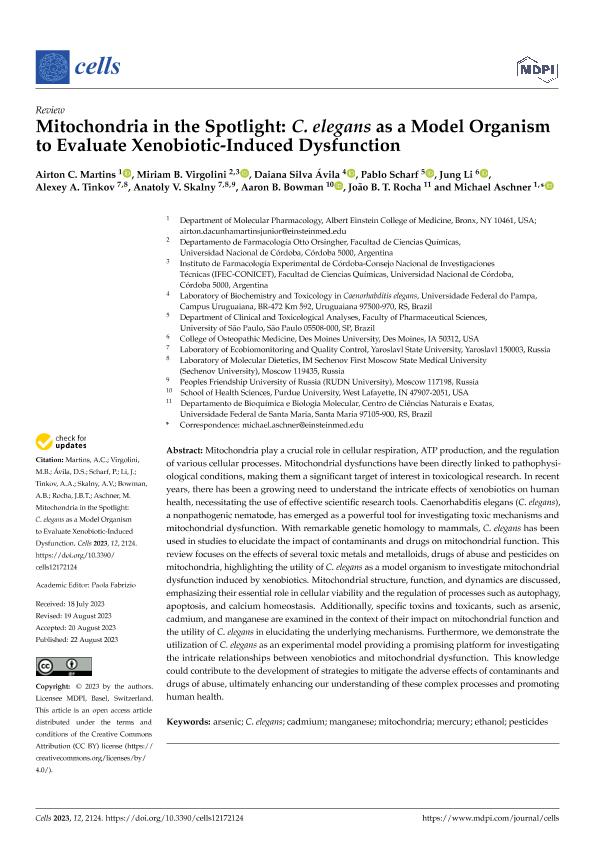Mostrar el registro sencillo del ítem
dc.contributor.author
Martins, Airton C.
dc.contributor.author
Virgolini, Miriam Beatriz

dc.contributor.author
Silva Ávila, Daiana
dc.contributor.author
Scharf, Pablo
dc.contributor.author
Li, Jung
dc.contributor.author
Tinkov, Alexey A.
dc.contributor.author
Skalny, Anatoly V.
dc.contributor.author
Bowman, Aaron B.
dc.contributor.author
Rocha, João B. T.
dc.contributor.author
Aschner, Michael
dc.date.available
2024-03-11T11:15:45Z
dc.date.issued
2023-09
dc.identifier.citation
Martins, Airton C.; Virgolini, Miriam Beatriz; Silva Ávila, Daiana; Scharf, Pablo; Li, Jung; et al.; Mitochondria in the Spotlight: C. elegans as a Model Organism to Evaluate Xenobiotic-Induced Dysfunction; MDPI; Cells; 12; 17; 9-2023; 1-28
dc.identifier.issn
2073-4409
dc.identifier.uri
http://hdl.handle.net/11336/229941
dc.description.abstract
Mitochondria play a crucial role in cellular respiration, ATP production, and the regulation of various cellular processes. Mitochondrial dysfunctions have been directly linked to pathophysiological conditions, making them a significant target of interest in toxicological research. In recent years, there has been a growing need to understand the intricate effects of xenobiotics on human health, necessitating the use of effective scientific research tools. Caenorhabditis elegans (C. elegans), a nonpathogenic nematode, has emerged as a powerful tool for investigating toxic mechanisms and mitochondrial dysfunction. With remarkable genetic homology to mammals, C. elegans has been used in studies to elucidate the impact of contaminants and drugs on mitochondrial function. This review focuses on the effects of several toxic metals and metalloids, drugs of abuse and pesticides on mitochondria, highlighting the utility of C. elegans as a model organism to investigate mitochondrial dysfunction induced by xenobiotics. Mitochondrial structure, function, and dynamics are discussed, emphasizing their essential role in cellular viability and the regulation of processes such as autophagy, apoptosis, and calcium homeostasis. Additionally, specific toxins and toxicants, such as arsenic, cadmium, and manganese are examined in the context of their impact on mitochondrial function and the utility of C. elegans in elucidating the underlying mechanisms. Furthermore, we demonstrate the utilization of C. elegans as an experimental model providing a promising platform for investigating the intricate relationships between xenobiotics and mitochondrial dysfunction. This knowledge could contribute to the development of strategies to mitigate the adverse effects of contaminants and drugs of abuse, ultimately enhancing our understanding of these complex processes and promoting human health.
dc.format
application/pdf
dc.language.iso
eng
dc.publisher
MDPI

dc.rights
info:eu-repo/semantics/openAccess
dc.rights.uri
https://creativecommons.org/licenses/by/2.5/ar/
dc.subject
ARSENIC
dc.subject
C. ELEGANS
dc.subject
CADMIUM
dc.subject
ETHANOL
dc.subject
MANGANESE
dc.subject
MERCURY
dc.subject
MITOCHONDRIA
dc.subject
PESTICIDES
dc.subject.classification
Toxicología

dc.subject.classification
Medicina Básica

dc.subject.classification
CIENCIAS MÉDICAS Y DE LA SALUD

dc.title
Mitochondria in the Spotlight: C. elegans as a Model Organism to Evaluate Xenobiotic-Induced Dysfunction
dc.type
info:eu-repo/semantics/article
dc.type
info:ar-repo/semantics/artículo
dc.type
info:eu-repo/semantics/publishedVersion
dc.date.updated
2024-03-08T14:24:08Z
dc.journal.volume
12
dc.journal.number
17
dc.journal.pagination
1-28
dc.journal.pais
Suiza

dc.description.fil
Fil: Martins, Airton C.. Albert Einstein College of Medicine; Estados Unidos
dc.description.fil
Fil: Virgolini, Miriam Beatriz. Consejo Nacional de Investigaciones Científicas y Técnicas. Centro Científico Tecnológico Conicet - Córdoba. Instituto de Farmacología Experimental de Córdoba. Universidad Nacional de Córdoba. Facultad de Ciencias Químicas. Instituto de Farmacología Experimental de Córdoba; Argentina
dc.description.fil
Fil: Silva Ávila, Daiana. Universidade Federal do Pampa; Brasil
dc.description.fil
Fil: Scharf, Pablo. Universidade de Sao Paulo; Brasil
dc.description.fil
Fil: Li, Jung. Des Moines University; Estados Unidos
dc.description.fil
Fil: Tinkov, Alexey A.. Yaroslavl State University; Rusia
dc.description.fil
Fil: Skalny, Anatoly V.. Yaroslavl State University; Rusia
dc.description.fil
Fil: Bowman, Aaron B.. Purdue University; Estados Unidos
dc.description.fil
Fil: Rocha, João B. T.. Universidade Federal de Santa Maria; Brasil
dc.description.fil
Fil: Aschner, Michael. Albert Einstein College of Medicine; Estados Unidos
dc.journal.title
Cells

dc.relation.alternativeid
info:eu-repo/semantics/altIdentifier/doi/http://dx.doi.org/10.3390/cells12172124
Archivos asociados
